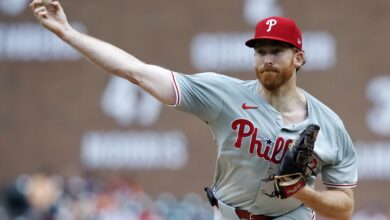
Cubs Connected to Most of Highest-Ranked Players in Keith Law’s Top 50 Free Agent List
First things first, I have to say that I had some serious trouble understanding Keith Law’s top 50 free agent rankings for The Athletic when I first saw them. The list is very subjective, which I suppose is always the case with these things, but I couldn’t entirely wrap my head around the way it was all prioritized. Law seems to be ordering players based on how likely they are to generate a perceived value relative to the deal they end up signing.
Specifically, he “ranked them according to…what I think they’re likely to be worth, considering their likely future production, playing time, and growth or regression over the life of such a contract.” So a lot of it is a matter of fit rather than pure talent or something a little more quantifiable.
Looking at it that way makes a little more sense and accounts for Jurickson Profar coming in at No. 11, two spots ahead of Justin Verlander. This view also fits with the notion that intelligent spending isn’t simply about avoiding big contracts. The Cubs may actually spend a whole lot of money this winter, it’ll just be targeted at immediate impact with minimal long-tail regression risk.
“To me, intelligent spending involves making decisions that make sense for the 2023 season but also aren’t going to hinder what we’re trying to build,” Jed Hoyer said during his end-of-season press conference. “The nature of baseball contracts is challenging that way. We’ve all seen contracts of certain lengths that can really bog a team down.
“It’s easy to talk about the player you’re acquiring, but if that contract ends up hindering the ultimate goal here, which is to build something special and sustainable and lasting, then it wasn’t a good transaction.”
When you lay Hoyer’s quote on top of Law’s criteria, you see a lot of similarities. Perhaps that’s why the Cubs have been discussed in connection with just about every member of the top 10 and nine of top 13 players on the list. Some of that is purely positional, as shortstops heavily populate the upper reaches with four of the first five slots, and Willson Contreras is connected by virtue of his past even though his future may be elsewhere.
The quartet of Carlos Correa, Trea Turner, Dansby Swanson, and Xander Bogaerts is joined by Aaron Judge at the top, then it’s Contreras at No. 6, Jacob deGrom at No. 8, and Carlos Rodón right behind. While some have mentioned Brandon Nimmo in passing as a potential Cubs target, I wouldn’t consider that thought to have much merit. Jameson Taillon is the only other member of the top 10 who hasn’t been discussed as a legit option.
We have to drop down to 18 to find Kodai Senga, whose command and ability to stick as a starter are called into question. That tracks with another recent report on the Japanese righty, whose fastball apparently doesn’t generate called strikes at a very high rate. My counter is that the Cubs aren’t looking for a workhorse and that Senga’s combo of triple-digit velo and a true weapon of a splitter makes him more than suitable for a starting role with a team that may be evolving in terms of pitcher usage.
Also of note here is that Law sort of estimates a deal in the range of “four years and $80 million-plus,” which fits the Cubs’ perceived MO. If Hoyer and Carter Hawkins can limit deals to under five years, which is possible for just about everyone other than the shortstops, they’ll gladly juice the AAV. To that end, it was interesting to see Law suggest Verlander should seek a string of one-year deals in order to optimize his ability to stack up wins in pursuit of 300.
There are a pair of first basemen a little further down the list, both of whom have been heavily connected to the Cubs in one way or another. Law isn’t the least bit bullish on either, though he said he’d love a one-year, $20 million deal for José Abreu. I agree with that and also the assertion that anything longer than two years could be rough. Anthony Rizzo is ranked a few spots higher, though that seems to have more to do with the fact that Law believes Rizzo might end up getting less than the $16 million he walked away from with the Yankees.
Again, this all comes back to the idea of finding value in new deals even if the average cost is a little higher than what market projections hold right now. The Cubs have a great deal of payroll flexibility on paper and they’ll have more after next season when Jason Heyward, Kyle Hendricks, and possibly Ian Happ fall off the books. Inking deals of 1-3 years would allow them to maintain that flexibility without blocking the development pipeline and possibly pushing them into trading prospects who have nowhere to go.
As strange as Law’s list appears on paper, and there are still some choices I can’t reconcile, it makes more sense to me after running it through my metaphorical Rosetta Stone. Unless my interpretation is completely jacked and I’m just chasing my own tail. Whatever, I’ll stand by this because I like how it maintains the concept I’ve built around Hoyer’s strategy for the offseason.

